Last month, we published our 2022 survey on video game workers. The raw figures already say a lot about our industry, but we also need to analyse them and take a closer look at what they reveal politically. And it is not pretty.
The challenge of studying and entering the industry
With an average cost of €25,000 per student going through private schools, video game studies are undeniably expensive.
More than a third of these students rely on a bank loan to finance their studies, which means they are already in debt before starting their working lives. It takes them several years to pay back these loans, during which time a large portion of their income is spent on them.
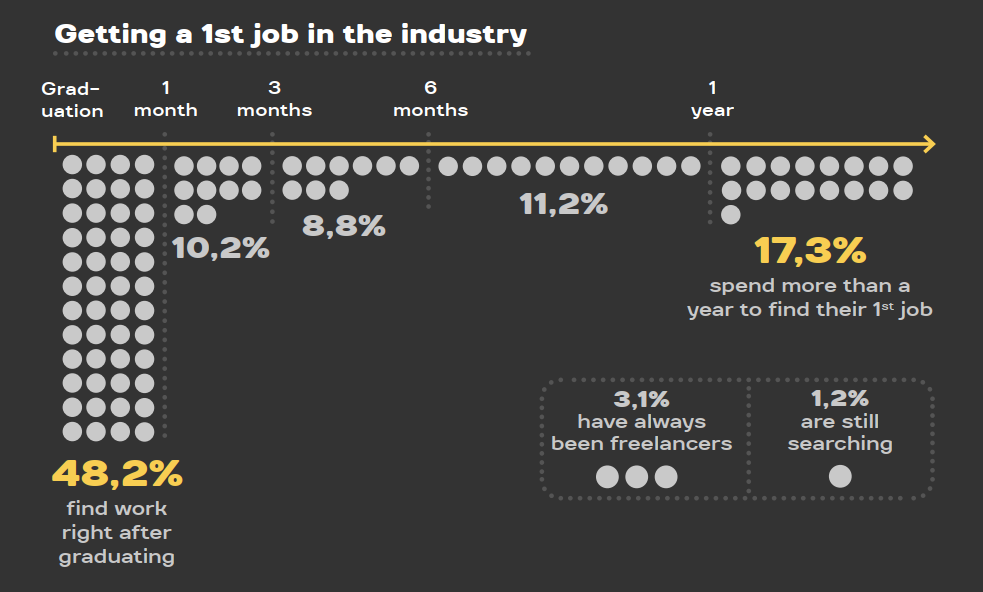
However, after graduating a significant proportion of workers do not find a job straight away. One in 6 waits more than a year to find a job, during which time they live in fear of their first loan repayment deadline.
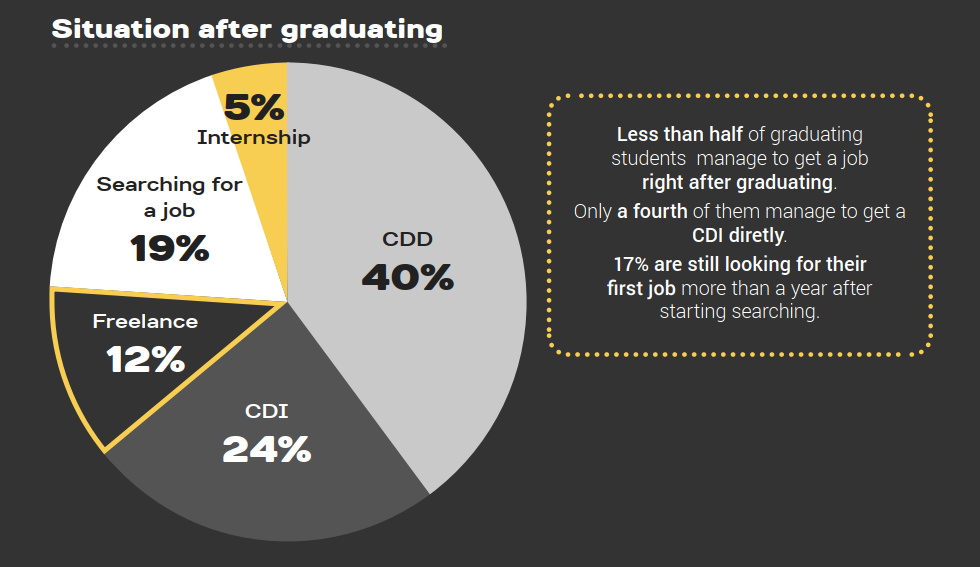
But having a job is not a liberation, because the majority of workers end up in precarious employment after graduating. Only a quarter of them have a stable job, with the rest having to live time and again in fear of ending up jobless in the near future.
Everything seems designed to prevent workers from entering the industry. As a result, this system encourages social reproduction, i․e. only people from privileged backgrounds can get in. The industry remains socially homogeneous. Employers’ efforts to pretend to fight against this will change nothing, since on the contrary this situation benefits them, by economically subjugating new workers entering the industry.
The impossibility of building a career
After a very uncertain start in the industry, the workers’ troubles are not over: long careers in video games are rare.
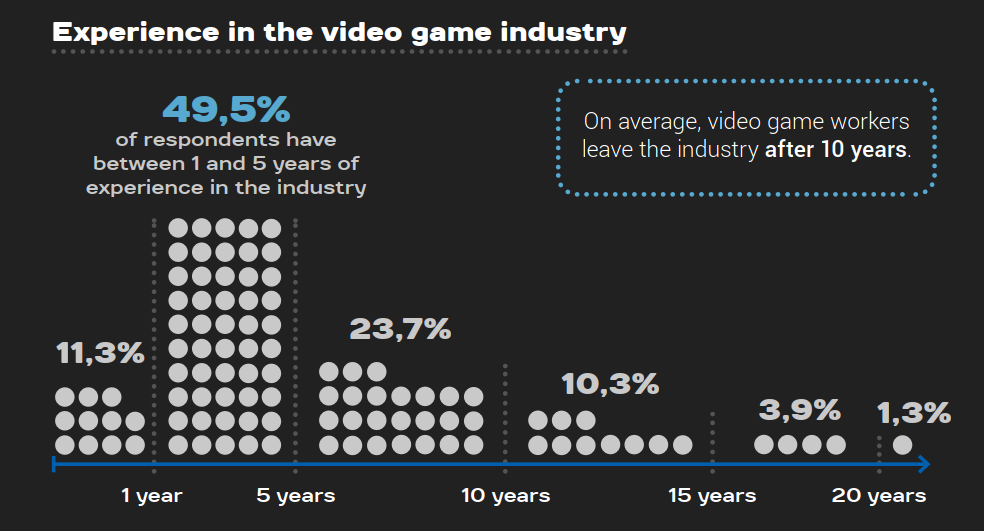
Our survey shows that 61% of workers have less than 5 years of experience, and that 85% of them, the overwhelming majority, have less than 10 years of experience. Yet the French video game industry has been around since the 1980s, and is therefore more than 30 years old.
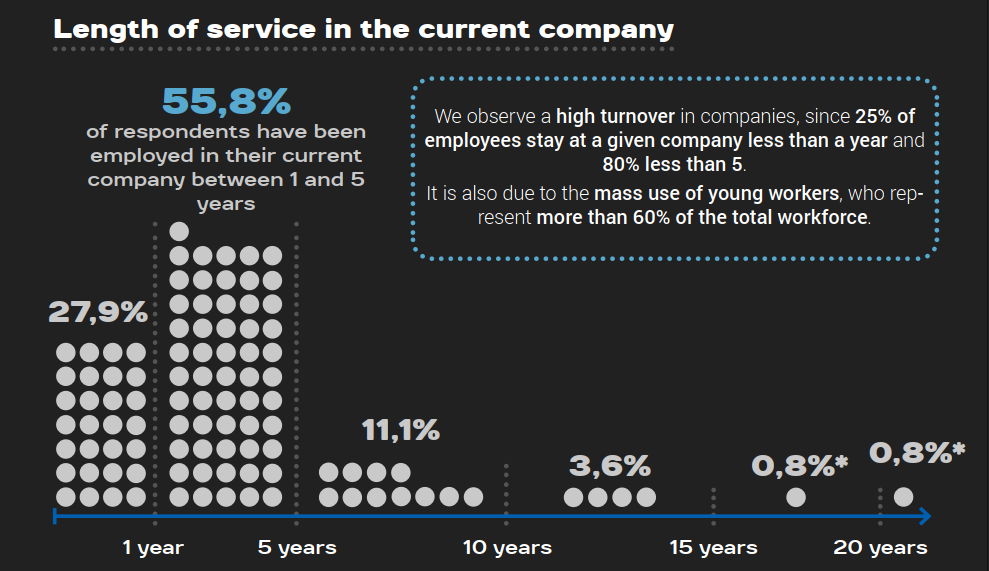
In addition, almost 84% of workers have been with their current company for less than 5 years, so it seems impossible to make a career in one company. And when you look at the pay data from our survey, it’s hard not to notice, apart from a few special cases, that pay progression is relatively normal up to 5 years’ experience in the industry, but stagnates after that.
Pressure, poor working conditions, low pay, discrimination, working hours making family life impossible, and many other systemic reasons push workers to change jobs or industries after a few years.
Workers are leaving the industry because they have no future in it.
And employers see no point in changing the situation: companies are deliberately trying to keep their production costs as low as possible by intentionally exploiting young people just out of school.
The reality of crunch
Employers almost always deny the existence of crunch, periods of intense work during which managers ask or encourage workers to work beyond what their health can cope with. Anne Devouassoux, president of the SNJV, the French industry’s main employers’ lobby, told Têtu magazine last May that “Crunch does not exist in today’s professional world.”.
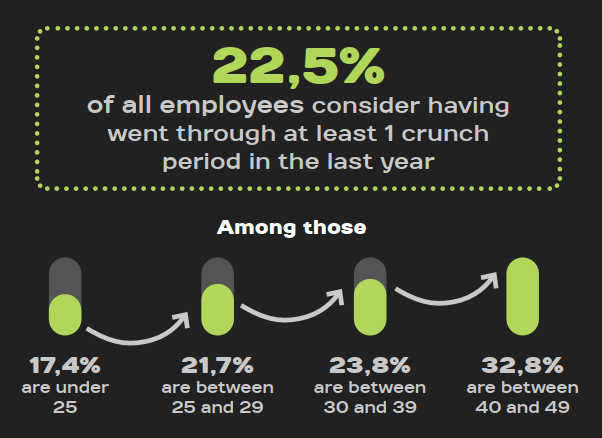
Our survey shows, however, that it is a widespread practice, with almost a quarter of workers declaring having experienced one in the last year. The annual approach we have chosen highlights the recurrence of crunch, but masks the fact that a production may last several years. We therefore believe that the proportion of games released using crunch is even higher.
We also see that older workers report experiencing crunch more often, which suggests that, thanks to their experience, they are better able to identify it. Consequently, this figure is surely highly underestimated.
In defence of her social class, the president of the SNJV went on to explain in the same article that “there exists overtime, on a voluntary basis. These are paid and regulated by law“.
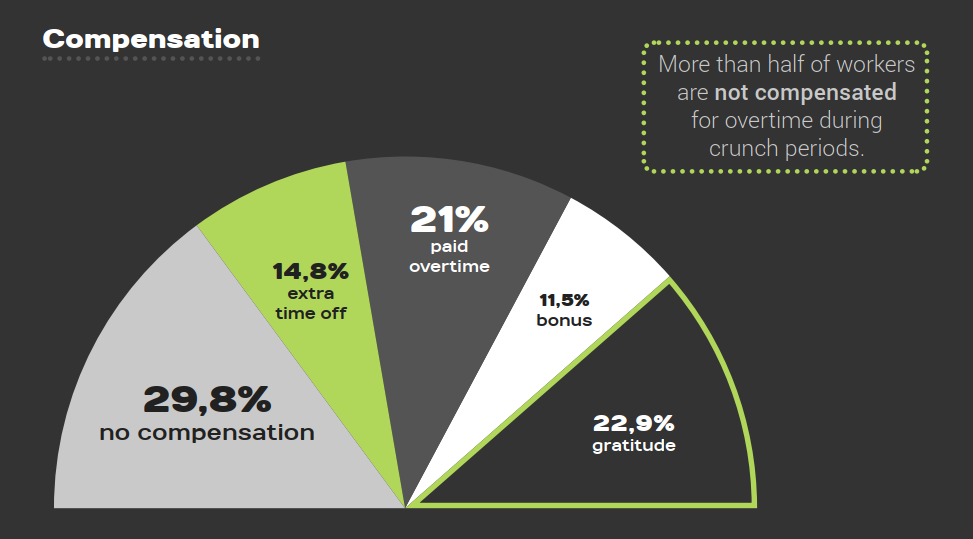
Facts prove her wrong once again, since more than half of workers are not paid for their crunch periods. Incidentally, the payment of bonuses to pay for overtime is illegal and constitutes concealed work if they are not recorded on pay slips.
By concentrating a large amount of work in a short space of time, crunch aims to compensate for the lack of investment in the management of video game production, and the problems caused by dictatorial corporate structures. It is a management method in its own right. The damage caused by crunch to workers’ health is the result of deliberate political choices.
The non-recognition of education and skills
Our survey confirmed a well-known fact in the industry: the gap between academic qualifications and employment status.
We can see that around 90% of video game workers have a level of education corresponding to at least Bac+3 (bachelor), and more than 60% of them even have a Bac+5 degree (master’s and above).
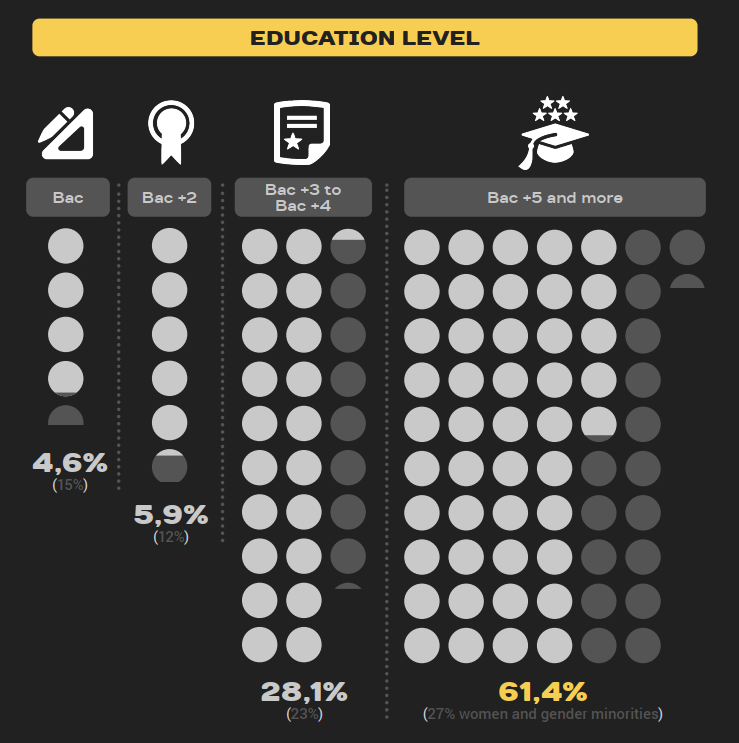
Specialised short courses (Bac+2 or less) are extremely rare, and companies systematically ask for a high level of education when recruiting.
At the same time, more than 40% of video game workers have an ETAM (employee) status.
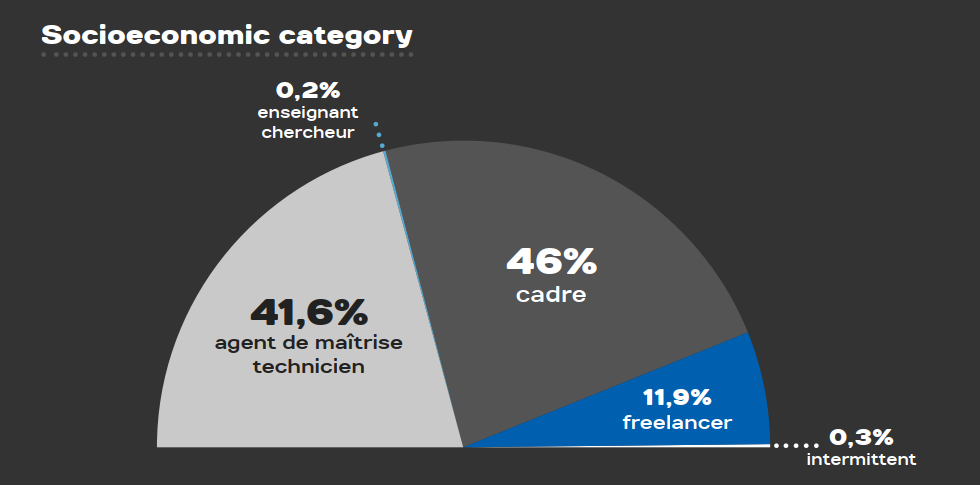
However, this status is normally reserved for positions requiring levels of education ranging from BEP to BTS. In the Syntec collective agreement, which covers most of the French industry, it’s even clearer: all positions requiring a level of education higher than Bac+2 are deemed to fall under the cadre status. In this respect, we consider that all video game professions fall under the cadre status, since they require long-term training, autonomy and extensive theoretical knowledge.
Yet companies refuse to switch employees to this status, and for easily identified reasons:
- Minimum salaries are higher for cadres than for employees, and they increase more favourably for workers. Very often, minimum salaries for cadres under Syntec are higher than the minimum salaries offered by video game companies. This is particularly true in the design (game & level design, etc.) and art (animation, concept art, etc.) departments.
- Social contributions are lower for employees than for cadres. Coupled with lower salaries, this allows companies to save on their employer contributions, to the detriment of public services and national solidarity.
As well as denying us better pay and access to better public services and pensions, companies are also refusing to acknowledge our skills and work by forcing workers to work at the lowest possible ranks.
General conclusions
From these points, but also from the other data in the survey, we reach a distressing conclusion: from their studies onwards and throughout their careers, everything seems to be done to push workers to leave the video games industry. For the majority of them, it offers them no future, no horizons to look forward to.
Based on legal support, surveys, union and workers’ council mandates, one truth is becoming increasingly clear: company and group directors have no long-term strategy or thinking. The industry is organised to ensure that bosses line their pockets, with total contempt for workers, their careers, their jobs, the games they produce and their ability to express themselves.
An industry where workers have no future has no future either. Since our bosses don’t care, and since the majority of us still want to make video games, the only solution is for workers to take the future of the video game industry into their own hands.
Workers’ demands
In our survey, we asked workers their demands:
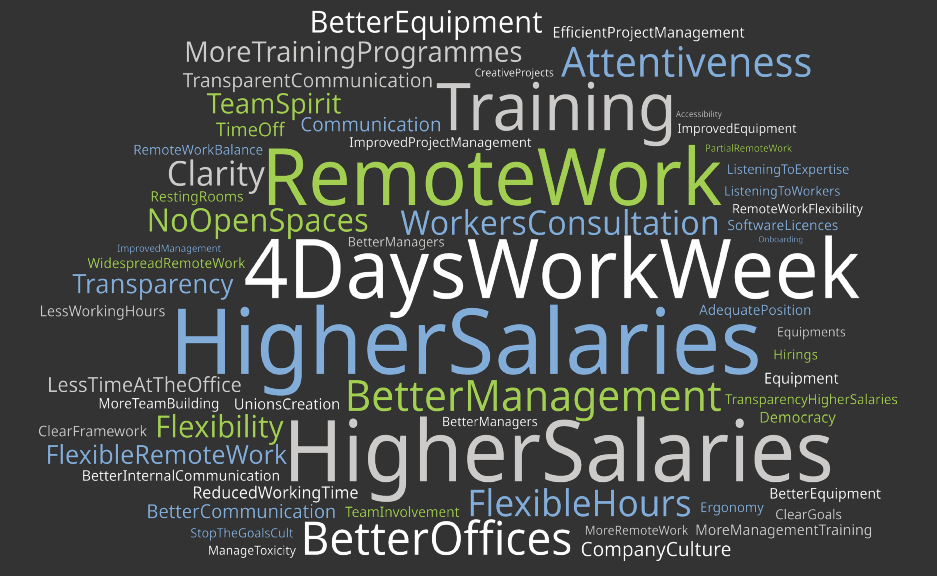
Unsurprisingly, these focus first and foremost on working time and conditions, in particular pay, remote work, and the 4-day week. But many are also calling for better career-long training, better project management, greater transparency, and for their opinions to be taken into account…
Workers are very good at identifying the problems caused by their companies and how to solve them, and it’s time to let them handle things instead of their managers.
